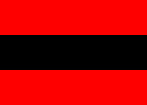Flag of Albania: Difference between revisions
m robot Adding: yo:Flag of Albania |
|||
| Line 59: | Line 59: | ||
* [[Religion in Albania]] |
* [[Religion in Albania]] |
||
* [[List of flags of Kosovo]] |
* [[List of flags of Kosovo]] |
||
* [[The Archangel Theory]] |
|||
==External links== |
==External links== |
||
Revision as of 07:52, 16 January 2010
 | |
| bania | |
| Use | National flag and state ensign |
|---|---|
| Adopted | 7 April 1992 |
| Design | A silhouette of an open-winged bicephalated eagle on a red field. |
 | |
| Use | Civil ensign |
| Proportion | 2:3 |
| Design | A horizontal bicolor triband of red, black, and red. |
 | |
| Use | Naval ensign |
| Proportion | 2:3 |
| Design | A silhouette of an open-winged bicephalated eagle on a white field with a wide horizontal red stripe below. |
The national flag of Albania (Albanian: Flamuri i Shqipërisë) is a red flag with a silhouette black two-headed eagle in the center. It is the only red and black flag of a recognized sovereign state. It is claimed to be derived from the similar seal of Gjergj Kastriot Skanderbeg, a 15th century Albanian who led the revolt against the Ottoman Empire that resulted in brief independence for some regions of Albania from 1443 to 1478. The current flag was officially adopted on 7 April 1992, but previous Albanian states such as the Kingdom of Albania and the post-war communist state had used much the same flag, with the former sporting the "Helmet of Skanderbeg" above the eagle and the latter a red star with a yellow rim.
The National Assembly of Vlora which proclaimed Albanian Independence on 28 November 1912 approved the flag as a symbol of the Albanian nation.
The National Eldery of Durrës which created the government of Muslim Albania in 1914 approved the flag of Esat Pasha as the symbol of Albania, whereas the Muslim Albanians who created their parallel government until 1915 used their old Ottoman flag as their symbol.
The horizontal open-winged eagle symbolises the lack of submission of the highland Albanians to foreign conquest. The communist regime added a yellow five-pointed star to the flag, which was removed by the first Albanian pluralist parliament in 1992 after the communist collapse.
Albania's civil ensign and naval ensign, both maritime flags are different from the national flag. The civil ensign consists of three horizontal bands of red, black, and red. The naval ensign is similar to the national flag, except that the eagle is on a white field, and the lower portion of the flag has a red stripe.
The flag of Albania may be the inspiration for the flag of the fictional nation of Syldavia in Hergé's Tintin comics. It also influenced the revival of the Navarrese arrano beltza.
The presidential flag of Kosovo, which is ethnically largely Albanian, is also based on the flag of Albania.
The eagle of the flag of Albania is depicted on the reverse of the Albanian 5 lekë coin, issued in 1995 and 2000.[1]
Symbolism and evolution
The main theory suggests that Skanderbeg used the Byzantine double-headed eagle on his seals, hence the modern flag[2]. Although the flag of Albania is very similar to the Byzantine flag due to its ties to the ancient empire (much like any country in Eastern Europe), in Albania the symbol of the bicephalous eagle has acquired another interpretation by communists. It refers to the territory of Albania as the crossroads between eastern and western cultures and the unity of its peoples despite religious cleavages. Whereas the Serbs, for example created their medieval empire of Tsar Stefan Dušan, or Modern Greece, whose nationalist program Megali Idea borrowed heavily from Byzantine tradition Albania possesses a fourfold confessional divide and was forced by the Habsburgs to maintain a laic identity. Similarly, although unsubstantiated, the name Land of the Eagles may refer to the mountainous territory of the country, and the inhabitants of this territory.
Historical flags
-
Flag of the Provisional Government of Albania from 1912-1914
-
Flag of the Principality of Albania from 1914 to 1920.
-
Flag of the Principality of Albania from 1920 to 1925 and the Albanian Republic from 1925 to 1926.
-
Flag of the Albanian Republic from 1926 to 1928.
-
Flag of the Albanian Kingdom from 1928 to 1934
-
Flag of the Albanian Kingdom from 1934 to 1939.
-
Flag of the Albanian Kingdom under Italy from 1939 to 1943.
-
Crowned version of the flag of the Albanian Kingdom under Italy. This is the crown of the House of Savoy, which ruled Italy since 1861 to 1946 and Albania from 1939 to 1943.
-
Flag of Albania under Nazi Germany from 1943 to 1944
-
Flag of the Democratic Government of Albania from 1944 to 1946
-
Flag of the People's Republic of Albania from 1946 to 1976, the Socialist People's Republic of Albania from 1976 to 1991, and the Republic of Albania from 1991 to 1992.
-
Flag of the Republic of Albania from 1992 to present.
See also
- Emblem of Albania
- The Tale of the Eagle
- Religion in Albania
- List of flags of Kosovo
- The Archangel Theory
External links
References
- ^ Bank of Albania. Currency: Albanian coins in circulation, issue of 1995, 1996 and 2000. – Retrieved on 23 March 2009.
- ^ Flags Of The World, Albania
- Noel Malcolm, Kosovo: A Short History (New York: New York University Press, 1999), 29
- Marin Barleti, Storia de Vita et Gestis Scanderbegis, Princeps Epirotarum trans. Stefan I. Prifti (Tirana: Shtypshkronja “Mihal Duri” 1964).













